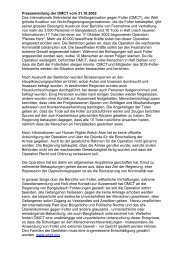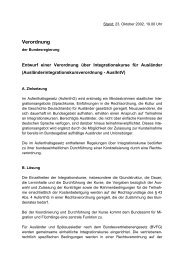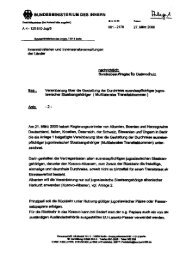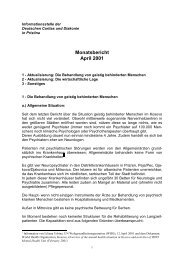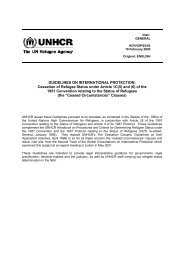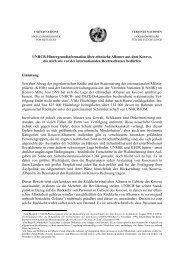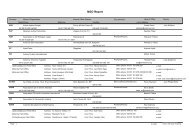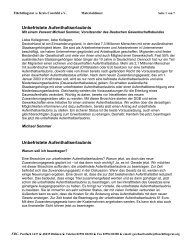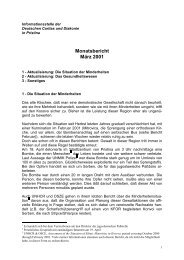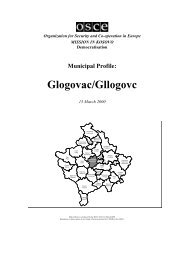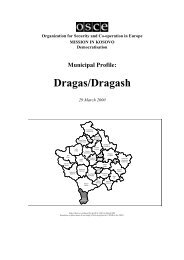Orahovac Municipal Profile
Orahovac Municipal Profile
Orahovac Municipal Profile
Create successful ePaper yourself
Turn your PDF publications into a flip-book with our unique Google optimized e-Paper software.
Organization for Security and Co-operation in Europe<br />
MISSION IN KOSOVO<br />
Democratisation<br />
<strong>Municipal</strong> <strong>Profile</strong>:<br />
<strong>Orahovac</strong>/Rahovec<br />
Pec<br />
Peje<br />
Decani<br />
Decan<br />
Djakovica<br />
Gjakove<br />
Istok<br />
Istog<br />
1 April 2000<br />
Zubin Potok<br />
Zubin Potok<br />
Klina<br />
Kline<br />
ORAHOVAC<br />
RAHOVEC<br />
Srbica<br />
Skenderaj<br />
Prizren<br />
Prizren<br />
Gora<br />
Dragashi<br />
Leposavic<br />
Leposaviq<br />
Zvecan<br />
Zvecan<br />
Glogovac<br />
Gllogoc<br />
Kosovska<br />
Mitrovica<br />
Mitrovice<br />
Vucitrn<br />
Vushtrri<br />
Obilic<br />
Obiliq<br />
Kosovo Polje<br />
Fushe Kosove<br />
Lipljan<br />
Lipjan<br />
Podujevo<br />
Podujeve<br />
Pristina<br />
Prishtine<br />
Novo Brdo<br />
Novo Berde<br />
Stimlje<br />
Shtime<br />
Suva Reka<br />
Suhareke<br />
Urosevac<br />
Ferizaj Vitina<br />
Viti<br />
Strpce<br />
Shterpce<br />
Kacanik<br />
Kacaniku<br />
Gnjilane<br />
Gjilani<br />
Kosovska<br />
Kamenica<br />
Kamenica<br />
Map of Kosovo, produced by the HCIC GIS Unit March 2000.<br />
Boundaries or place names do not imply official recognition by UNMIK or the OSCE.
Table of Contents<br />
1. Introduction..........................................................................................................3<br />
Table 2.1: Ethnic Composition, Including IDPs......................................................3<br />
2. Civil Administration ............................................................................................3<br />
Table 3.1: UN-Appointed <strong>Municipal</strong> Council .........................................................4<br />
Table 3.2: UN-Appointed <strong>Municipal</strong> Administrative Board...................................5<br />
3. Political Parties.....................................................................................................5<br />
Table 4.1: Political Parties......................................................................................5<br />
4. Local and International NGOs ............................................................................6<br />
Table 5.1: Local NGOs...........................................................................................6<br />
Table 5.2: International NGOs working in the municipality....................................6<br />
5. Other Civilian International Presence.................................................................6<br />
Table 5.1: The Four Pillars .....................................................................................7<br />
Table 5.2: Other International Organisations and Agencies.....................................7<br />
6. Religion and Places of Worship ...........................................................................7<br />
Table 6.1: Main Religious Leaders .........................................................................7<br />
Table 6.2: Major Mosques, Churches, etc...............................................................7<br />
7. Media....................................................................................................................8<br />
Table 7.1: List of Major Newspaper, TV/Radio Stations, etc. .................................8<br />
8. Judicial System.....................................................................................................8<br />
Table 8.1: Judges of the <strong>Municipal</strong> Court ...............................................................8<br />
Table 8.2: Judges of the Minor Offences Court ......................................................8<br />
9. Police, Civil Protection, and Military Presence...................................................8<br />
Table 9.1: Police and Military Presence..................................................................9<br />
10. Economics...........................................................................................................9<br />
10.1 Major Employers in the Region ......................................................................9<br />
11. Infrastructure.....................................................................................................9<br />
12. Social Services, Health, and Education ...........................................................10<br />
Appendix: Map of the <strong>Municipal</strong>ity<br />
This document may be multiplied and freely circulated<br />
but should not be quoted without stating the source.<br />
2
1. Introduction<br />
The municipality of <strong>Orahovac</strong>/Rahovec is located in the south-western part of the<br />
province, covers an area of approximately 280 km² and includes 34 villages. 1 Some of<br />
them, such as Zociste, have been completely destroyed, while others sustained only<br />
minimum damage. On average, about 65% of the houses in the municipality have<br />
been more or less destroyed.<br />
<strong>Orahovac</strong>/Rahovec municipality has an estimated population of 66,000, of which<br />
about 38.000 live in rural areas and about 27,000 live in urban areas. According to a<br />
UNHCR estimate from the end of 1999, Kosovo Albanians make up about 90% of the<br />
population, Kosovo Serbs 8%, while the rest are mainly Roma and Egyptians.<br />
In <strong>Orahovac</strong>/Rahovec town there is still a large Kosovo Serb Community. Before the<br />
war, the population of <strong>Orahovac</strong>/Rahovec town was 84% Kosovo Albanian, 13% Serb<br />
and 3% from other ethnicities (Montenegrins, Turks, Gorani, Roma, and Egyptians), 2<br />
and although many Kosovo Serbs have left, their presence is still substantial. They<br />
are mainly located in the so-called “Serb quarter” (upper part of town) and in the<br />
nearby village of Velika Hoca. The Romas are living in the same, segregated area.<br />
The presence of a large Kosovo Serb community in close proximity to the Kosovo<br />
Albanians has led to tensions among the two ethnic communities and turned<br />
<strong>Orahovac</strong>/Rahovec into a symbolic place in the Prizren region. For this reason, the<br />
local OSCE Field Office has aimed to implement a reconciliation policy in the area, in<br />
co-operation with the other UNMIK pillars and KFOR.<br />
Table 2.1: Ethnic Composition, Including IDPs<br />
Population K-Albanians K-Serbs Other Total<br />
Number % Number % Number % Number %<br />
1991 census 55,119 92 3,938 7 885 1 59,942 100<br />
January 1999 52,500 92 4,000 7 800 1 57,300 100<br />
December 1999 58,772 89 5,008 8 2116 3 65,896 100<br />
Source: 1991 census, OSCE/KVM Report (January 1999), UNHCR/HCIC Kosovo<br />
Database (December 1999). All population figures are subject to a wide margin of error.<br />
2. Civil Administration<br />
UN Civil Administration (UNCA) was upon its arrival in the municipality in August<br />
1999 confronted with a blockade established by Kosovo Albanians on the road<br />
leading to the town of Malisevo. This action was taken in order to prevent the planned<br />
deployment of Russian KFOR troops in the area. Kosovo Albanians claimed that<br />
Russian paramilitary soldiers had taken an active part to the Serbian offensives and<br />
committed crimes against the Albanian population. UNCA has since actively taken<br />
part in ‘reconciliation round tables’ together with OSCE and the other UNMIK<br />
1 This report is based on the post-1991 boundaries of <strong>Orahovac</strong>. Currently, UNMIK is in the process<br />
of redrawing the boundaries to re-establish the municipality of Malisevo, which previously covered<br />
part of <strong>Orahovac</strong> municipality. However, the exact locations of the revised boundaries for <strong>Orahovac</strong><br />
municipality have not yet been determined. Some figures taken from secondary sources may be<br />
somewhat inaccurate, since they may be based on the pre-1991 boundaries, which many Kosovo<br />
Albanians have regarded as the legitimate boundaries of <strong>Orahovac</strong> also after 1991.<br />
2 UNHCR Kosovo Village List of March 1999. The estimates may have a wide margin of error.<br />
3
pillars. Due to the initial weak position of the UN Civil Administration the<br />
relationship with the self-appointed authorities was often problematic.<br />
However, the signing of the 15 December Agreement on Kosovo-UNMIK Joint<br />
Interim Administrative Structure (JIAS) marked an increase in the effectiveness of<br />
UNCA activities and policies. The UNCA was since then deeply involved in<br />
consultations with political parties in order to form the new structures locally. The<br />
<strong>Municipal</strong> Council and part of the Administrative Board were simultaneously<br />
established on 25 February 2000. The two main political forces in town, Ibrahim<br />
Rugova’s Democratic League of Kosovo (LDK) and Hashim Thaci’s Party of<br />
Democratic Progress in Kosovo (PPDK), were together allocated half of the available<br />
seats. Despite some objections concerning the representation of the Kosovo Serb<br />
community (both from <strong>Orahovac</strong> town and from the village of Velika Hoca), an<br />
agreement was found on the number of administrative departments (10) and their<br />
directors.<br />
Nevertheless, during the opening session of the <strong>Municipal</strong> Council on 2 March 2000,<br />
the UNCA and some political parties clashed on a very sensitive issue, namely how to<br />
select and recruit local civil servants. Some political parties claimed their right to<br />
nominate the candidates directly, whereas the UNCA supported a public<br />
announcement system. Finally, the UN option was accepted and applications forms<br />
submitted. After long-lasting consultations with UN authorities and the active support<br />
of the OSCE, the political parties reached an agreement on the expansion of the<br />
Administrative Board. In addition to the President and the 3 Vice-Presidents initially<br />
nominated, the Heads of Directorates were appointed on 23 March 2000.<br />
Table 3.1: UN-Appointed <strong>Municipal</strong> Council<br />
Name Function<br />
Mr. Kharras Kane<br />
(Mauritania)<br />
UN <strong>Municipal</strong> Administrator<br />
Bedredin Shehu LDK<br />
Xhemajli Zeqiri LDK<br />
Hysni Thaqi LDK<br />
Fehmi Cena LDK<br />
Qazim Qesku PPDK<br />
Xhemajli Haxhimustafa PPDK<br />
Gani Mullabazi PPDK<br />
Jusuf Gashi PPDK<br />
Smajl Latifi LKCK<br />
Ramadan Krasniqi LKCK<br />
Idriz Vuciterna PNDSH<br />
Xhemajli Hajrullaga PSDK<br />
Jovan Ðuricic Serbian minority<br />
Idriz Berisha Roma minority<br />
Agim Thaqi Independent (close to LKCK)<br />
Ismet Tara Independent (Former UCK Commander)<br />
4
Table 3.2: UN-Appointed <strong>Municipal</strong> Administrative Board<br />
Name Function Party-affiliation<br />
Mr. Kharras Kane<br />
(Mauritania)<br />
UN <strong>Municipal</strong> Administrator -<br />
Agim Thaqi President Close to LKCK<br />
Bedredin Shehu Vice-president LDK<br />
Qazim Qesku Vice-president PPDK<br />
Slaviša Kolašinac Vice-president Kosovo Serb<br />
Ismet Kercagu General Administration and Juridical Affairs PNDSH/PSDK<br />
Ibrahim Kryeziu Finances LDK<br />
Shani Mullabazi Economy PPDK<br />
Selim Metkamberi Urbanism, Utilities, Housing and Mobility PPDK<br />
Bajram Popaj Environment and Civil Protection LKCK<br />
Qefsere Haxhimustafa Health Care and Social Policy PPDK<br />
Esad Jaha Education, Culture and Sports LDK<br />
Salih Hoti Agriculture and Forestry LKCK<br />
Qemajl Kadiri Geodesy and Cadastre LDK<br />
Islam Gashi Reconstruction, Planning and Development LKCK<br />
3. Political Parties<br />
Like in most of the municipalities throughout Kosovo, the opposition between the two<br />
main Kosovo Albanian political parties, the LDK and the PPDK, has marked the local<br />
political arena. Shortly after the end of the war, all political parties in the municipality<br />
were involved in the ‘Blockade Council’, an institution that represented the protest of<br />
the Kosovo Albanians to the deployment of Russian troops in the area. Following the<br />
lifting of the blockade in November, which was achieved thanks to a joint initiative of<br />
the UNCA, the OSCE and KFOR, the local political parties focused their attention on<br />
the implementation of the JIAS agreement. Since December 1999 they actively took<br />
part in the consultations to form the new administrative structures. Despite different<br />
positions and often-diverging objectives, and in contrast to certain other<br />
municipalities in Kosovo, no acts of politically motivated intimidation have been<br />
registered among the political parties and their representatives.<br />
As far as the Kosovo Serb entities are concerned, the local political arena is not<br />
structured and there is no political party activity, although Kosovo Serbs meet in a<br />
local council to discuss issues of concern to the Kosovo Serb community. The<br />
council is headed by Slavisa Kolasinac, who is also one of the vice-presidents of the<br />
<strong>Orahovac</strong>/Rahovec Administrative Board.<br />
Table 4.1: Political Parties<br />
Party Local Party Leader Kosovo-wide Leader<br />
LDK (Democratic League of Kosovo) Bedredin Shehu Ibrahim Rugova<br />
PPDK (Party of Democratic Progress in Kosovo) Sebahajdin Cena Hashim Thaqi<br />
LKCK (Nat. Movement for the Liberation of K.) Smajl Latifi Sabit Gashi<br />
PNDSH (Albanian National Democratic Party) Idris Vuquiterna Rexhep Abdullahu<br />
PSDK (Social Democrat Party of Kosovo) Xhemajl Hairullaga Kaqusha Jashari<br />
LPK (People’s Movement of Kosovo) Durmish Gashi Emrush Xhemajli<br />
5
4. Local and International NGOs<br />
The local NGOs in the municipality are mainly focused on the distribution of food<br />
and non-food items. Their funds and resources are limited and this obstacle often<br />
reduces their effectiveness. For this reason, they rely upon financial and other support<br />
from international organisations and NGOs.<br />
Table 5.1: Local NGOs<br />
Name Main focus Local Leader Kosovo-wide Leader<br />
Mother Teresa Distribution Xheladin Rama Don Lush Gjergji<br />
HandiKos Medical assistance to<br />
handicapped persons<br />
Agim Metbala Halit Ferizi<br />
Until recently, the <strong>Orahovac</strong>/Rahovec area has been relatively neglected by<br />
international NGOs. Few of them are actually based in <strong>Orahovac</strong> town, since most of<br />
the NGOs working in town are based in Djakovica/Gjakova. The co-ordination<br />
between the different NGOs and other agencies, both local and international, is<br />
facilitated through a weekly meeting, usually chaired by UNHCR, in the municipality<br />
building. Most of the activities focus on the distribution of food and non-food items<br />
and on reconstruction. Most of the projects concern heavily damaged villages. The<br />
projects contribute to increasing the population’s confidence in the work of the entire<br />
international community in the municipality.<br />
Table 5.2: International NGOs working in the municipality<br />
Name Main focus Kosovo-wide<br />
Leader/Contact<br />
ADS (Acteurs de Solidarite) Distribution Bernard Pavon<br />
Pueblos Fraternos Distribution Alejandro Perez<br />
AMIKA Distribution, women’s support Annett Gerber<br />
ACT International Reconstruction Thorklind Hoyer<br />
Malteser Reconstruction Conrad Graf von Hoyos<br />
ICMC (International Catholic Shelter, reconstruction Dale Buscher<br />
Migration Commission)<br />
Diakonie Emergency aid Manfred Kuhle<br />
Tareas Solidarias Children’s support N/A<br />
CARITAS Belgium Distribution, support to local economy Jacques Dony<br />
5. Other Civilian International Presence<br />
The international civilian presence in the town of <strong>Orahovac</strong>/Rahovec includes 10<br />
international staff (five from the UN and 5 from the OSCE). The UN civil<br />
administration arrived in August 1999 whereas the local OSCE Field Office was fully<br />
operational from October 1999. As to the other UNMIK pillars, the UNHCR covers<br />
the area from its field office based in Gjakova/Djakovica. The EU pillar for<br />
Reconstruction and Development is not active in the municipality, although the<br />
European Community Monitoring Mission (ECMM) patrols travel to the location on<br />
an irregular basis from Prizren.<br />
6
Table 5.1: The Four Pillars<br />
Name Number of staff Contact Person Title Contact Number<br />
UN Civil Adm. 5 int. staff Kharras Kane <strong>Municipal</strong><br />
Administrator<br />
---<br />
OSCE 5 int. staff Walter Fleischer Head of Field Sat. Tel.+871-<br />
Office 762-138-664<br />
UNHCR Based in<br />
Paolo Foradori Field- Sat. Tel. +871-<br />
Gjakova/Djakovica<br />
Protection<br />
Officer<br />
761-846-870<br />
EU Not present --- --- ---<br />
Table 5.2: Other International Organisations and Agencies<br />
Name Main focus Kosovo-wide<br />
THW (Techniches Hilfswerk<br />
– German Governmental<br />
Agency)<br />
6. Religion and Places of Worship<br />
Leader/Contact<br />
Reconstruction Klaus Buschmuller<br />
The Islamic community, a highly respected institution, organises religious life in<br />
<strong>Orahovac</strong>/Rahovec town. As to the Kosovo Serb quarter and the Kosovo Serb enclave<br />
Velika Hoca, the Orthodox Priest represents a moral authority capable of partly filling<br />
the vacuum left by the previous political regime.<br />
Table 6.1: Main Religious Leaders<br />
Name and Place Religious Organisation<br />
Imam Shani Sylka (Sunnit) Islamic Community<br />
Sheh Baki Shehu (Shehit) Islamic Community<br />
Priest Stefan (Serb Quarter) Orthodox Church of Serbia<br />
Priest Milenko (Velika Hoca) Orthodox Church of Serbia<br />
Source: OSCE FO <strong>Orahovac</strong>/Rahovec<br />
Most religious sites are in a rather good condition. Some of them are lightly damaged,<br />
but more by negligence of the past regime than by the recent war. The few Orthodox<br />
churches in <strong>Orahovac</strong>/Rahovec town and the neighbouring village of Velika Hoca are<br />
protected by KFOR troops. Religious symbols have not been targeted by bomb or<br />
grenade attacks so far.<br />
Table 6.2: Major Mosques, Churches, etc.<br />
Place/Name Type of Building<br />
Town Square Mosque<br />
Kadiri Mosque<br />
Sokoli Mosque<br />
Cmega Mosque<br />
Serbian Quarter Orthodox Church<br />
Brnjaqa Orthodox Church<br />
Sheh Baki Teke (Muslim ‘monastery’ of the Dervish order)<br />
Sheh Medini Teke<br />
Source: OSCE FO <strong>Orahovac</strong>/Rahovec<br />
7
7. Media<br />
Unfortunately, there are no TV or radio stations in the municipality. Projects by a<br />
local group to create a radio station are being reviewed.<br />
Table 7.1: List of Major Newspaper, TV/Radio Stations, etc.<br />
Name of media Type of Media Editor/Correspondent Ethnic Affiliation<br />
Koha Ditore Newspaper Correspondent<br />
Bejtullah Sokoli<br />
Albanian<br />
Boom 2000 Student newspaper Albanian<br />
8. Judicial System<br />
On 29 December 1999, the judges for both the <strong>Municipal</strong> Court and the Minor<br />
Offenses Court in <strong>Orahovac</strong>/Rahovec were sworn in. There are a total of nine judges<br />
in <strong>Orahovac</strong>, all of which are Kosovo Albanian. In addition, three Kosovo Serbs<br />
(Velimir Vitosevic, Cvetko Vucic, and Vladimir Grkovic) serve as lay judges (acting<br />
in a legal capacity but without having had legal training) together with a number of<br />
Kosovo Albanian lay judges.<br />
Table 8.1: Judges of the <strong>Municipal</strong> Court<br />
Name Title Ethnicity<br />
Mr. Myhedin Bekeri Judge (President) Kosovo Albanian<br />
Mr. Hysen Gashi Judge Kosovo Albanian<br />
Mr. Rasim Zllonga Judge Kosovo Albanian<br />
Mr. Agim Metbala Judge Kosovo Albanian<br />
Mr. Jonuz Bugari Judge Kosovo Albanian<br />
Source: OSCE FO <strong>Orahovac</strong>/Rahovec<br />
Table 8.2: Judges of the Minor Offences Court<br />
Name Title Ethnicity<br />
Mr. Flamur Hasku Judge (President) Kosovo Albanian<br />
Mr. Gani Kastrati Judge Kosovo Albanian<br />
Mr. Mizahir Shabani Judge Kosovo Albanian<br />
Mr. Muharrem Bytyqi Judge Kosovo Albanian<br />
Source: OSCE FO <strong>Orahovac</strong>/Rahovec<br />
9. Police, Civil Protection, and Military Presence<br />
The work of the police in <strong>Orahovac</strong>/Rahovec seems to be effective and the cooperation<br />
with German and Dutch KFOR is well established. Although not all<br />
segments of the population are very co-operative with the police with regard to police<br />
investigations (including both Serbs and Albanians), generally speaking the<br />
multinational police force operating in the area is well accepted. Major concerns<br />
emanate from a number of recent bomb attacks and from a high level of crime in<br />
general.<br />
The Kosovo Police Service (KPS) presence is limited to 2 officers who are included<br />
in the UN police force. The Kosovo Protection Corps (TMK) includes 52 officers. Its<br />
8
former leader, Ismet Tara, was appointed member of the <strong>Municipal</strong> Council as an<br />
independent candidate in February 2000 and subsequently resigned from his post.<br />
Table 9.1: Police and Military Presence<br />
Name Local Commander Number of Police<br />
Officers, Soldiers, etc.<br />
9<br />
Ethnic Composition,<br />
Nationality<br />
KPS --- 2 Kosovo Albanian<br />
KPC/TMK Skender Hasangjekaj 52 Kosovo Albanian<br />
UN Civil Police Albert League (US) 42 American, French,<br />
Italian, Egyptian,<br />
Ghanean, Canadian,<br />
KFOR Lieutenant Colonel Manen<br />
(NL)<br />
Source: OSCE FO <strong>Orahovac</strong>/Rahovec<br />
10. Economics<br />
German<br />
N/A German and Dutch<br />
The economy rests largely on agriculture and in particular on vineyards and<br />
vegetables. There is some production of wheat, corn and some cattle breeding. There<br />
are a total of five enterprises dealing with agricultural production, while others deal<br />
with the production of plastics, heaters, and freezers and with recycling. These<br />
nominally state-owned companies have partly resumed their activities but are in need<br />
of financial assistance and infrastructure aid.<br />
10.1 Major Employers in the Region<br />
Employer Service/Products Production on<br />
going?<br />
Number of Workforce<br />
Tehnoremont Factory Plastic recycling No<br />
18 Th November Factory Plastic Yes Approx. 150<br />
Termovent Heaters and freezers Yes Approx. 100<br />
Rahoveci (former Wine and spirits Yes Approx. 200<br />
Orvin)<br />
Korenica Windows and Doors Yes Approx. 20<br />
Silos Flour Yes --<br />
Source: OSCE FO <strong>Orahovac</strong>/Rahovec<br />
11. Infrastructure<br />
Until very recently the electricity and water situation in <strong>Orahovac</strong>/Rahovec town and<br />
in the neighbouring villages has been quite disastrous. Until March 2000 some<br />
villages were not connected at all. In comparison with the rest of the province,<br />
<strong>Orahovac</strong>/Rahovec has greatly suffered from the power shortages caused by the<br />
problems of Kosovo’s power stations. As for the telephone system, it has recently<br />
been fixed although it still only allows local calls.<br />
As far as garbage collection is concerned, thanks to the German Governmental<br />
Agency Technisches Hilfswerk (THW) this service is properly carried out on a daily<br />
basis. Finally, regarding the level of destruction of houses, approximately 30 percent<br />
have been at least partially destroyed. According to the estimates of Action by
Churches Together (ACT), an international NGO, 285 houses have been destroyed<br />
totally.<br />
Source: ACT<br />
12. Social Services, Health, and Education<br />
Most social services are taken care of by the Centre for Social Work. Due to lack of<br />
funds, this institution functions as a sort of co-ordination centre in close connection<br />
with the <strong>Municipal</strong>ity. There is no pension system in place, although the UN<br />
Emergency Assistance Financial Programme for over 70 year olds and disabled<br />
persons has been implemented.<br />
The local health sector includes one hospital and six health centres also known as<br />
“ambulanta”. With the help of German and Dutch KFOR, these structures provide<br />
basic medical treatment. For urgent and more complicated cases, the nearest wellequipped<br />
hospitals are located in Djakovica/Gjakova (Argentinean Military Hospital)<br />
and Prizren (German Military Hospital).<br />
The Education sector reflects the ethnic division of the area and all schools are<br />
completely ethnically segregated. The Kosovo Albanian side includes 31 primary<br />
schools and four secondary schools. The Kosovo Serb side includes three primary<br />
schools and one secondary school. Transport facilities are needed for about eight<br />
schools, and especially for the pupils from the Serb enclave Velika Hoca who need to<br />
reach the nearby high schools located in the Serb Quarter of <strong>Orahovac</strong> town.<br />
10



